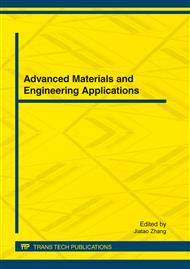p.11
p.15
p.21
p.26
p.30
p.37
p.42
p.47
p.53
Tensile Properties of 4D In-Plane C/C Composites
Abstract:
The tensile properties of 4D in-plane carbon/carbon (C/C) composites were researched by MTS machine and ARAMIS optical strain test system. A damage model for analysis the gradual damage was proposed, which chose hoffman criterion and twin shear strength theory as the failure criterion of fiber bundle and matrix, respectively. Cohesive zone model was used to simulate the interfacial debonding at the fiber bundle/matrix interface. The effect of shear strength of fiber bundle/matrix interface on the tensile strength was researched. It is shown that the major factor caused by the failure of the material at axial tensile is the interface debonding, which make the fiber bundle pull out from the matrix. The failure factor for the radical tensile is the crack through out the fiber bundle and matrix, and that make the material fracture. Simulation result shows the interface shear strength have a significant effect on the tensile strength. With the strength promote, the tensile strength increase, and the best value of interface strength is 11MPa.
Info:
Periodical:
Pages:
30-36
Citation:
Online since:
March 2012
Authors:
Price:
Сopyright:
© 2012 Trans Tech Publications Ltd. All Rights Reserved
Share:
Citation:


